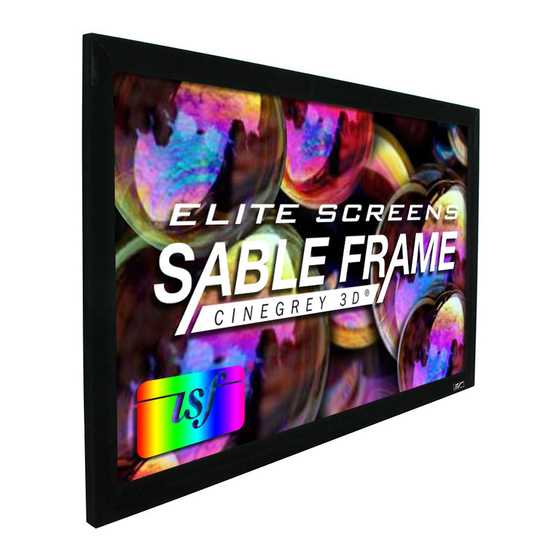Advertisement
Ambient Light Rejecting Fixed Frame Screen
Congratulations on your new Sable Frame purchase! The screen material included is our ISF Certified
CineGrey 3D which is a front projection material, precisely formulated for environments with minimal control
over room lighting. It was designed to enhance picture brightness, offer accurate color fidelity, and improve
contrast levels. The CineGrey 3D is best for family rooms, educational facilities, conference rooms, house of
worship or any applications in which incident light is a factor.
In order for the CineGrey 3D to maintain its projection qualities and optimum performance please refer to the list
below for proper maintenance and cleaning.
Use a dry microfiber cloth to remove dust from the screen's surface.
•
When cleaning, use a damp microfiber cloth with warm water to remove any marks.
•
Never rub or apply pressure when cleaning the surface.
•
Never attempt to use any solutions, chemicals or abrasive cleaners on the screen surface.
•
In order to avoid damaging the screen, avoid touching it directly with your fingers, pens/pencils or any
•
other sharp or abrasive objects.
Assembly Video
Watch our assembly video on-line at
www.elitescreens.com/video/ezframeCG5D
or scan the QR code
5/17/2016-DR
Sable Frame CineGrey 3D
USER'S GUIDE (spring type)
www.elitescreens.com
1
Advertisement
Table of Contents

Summary of Contents for Elite Screens Sable Frame CineGrey 3D
- Page 1 Sable Frame CineGrey 3D Ambient Light Rejecting Fixed Frame Screen USER’S GUIDE (spring type) Congratulations on your new Sable Frame purchase! The screen material included is our ISF Certified CineGrey 3D which is a front projection material, precisely formulated for environments with minimal control over room lighting.
- Page 2 Frame P arts L ist A. Vertical F rame x 2 pcs B. ½ H orizontal F rame x 2 p cs C. ½ H orizontal F rame x 2 p cs ...
- Page 3 Frame Assembly Step 1. Place a soft-clean cloth on the ground of the area where the screen will be assembled. Step 2. Position the pieces of the frame on the soft-clean cloth in the arrangement shown below. ...
- Page 4 Step 6. Connect the elbow joints to top and bottom sections of the vertical frame. Once inserted, connect the vertical sections to the horizontal frame sections. Make sure all the holes are in alignment and the frames pieces are flush (no gaps). They should form perfect right angles. ...
- Page 5 Step 9. With one end of the spring and secure inside the groove of the frame, hook the spring to the hole located on the screen material’s outer edge. Use the pull hook when necessary. Attach the four corners first (1). After those are secure, connect the vertical portions of the material, begin in the center and move towards the corners (2).
- Page 6 Notice to Installer: Please use the following installation instructions to obtain superior optical performance from the CineGrey 3D Angular Reflective ALR (Ambient Light Rejecting) Screen. Make sure to follow these instructions in order for the CineGrey 3D to perform correctly. •Angular-Reflective material is not compatible with ultra/short-throw projectors •Minimum lens throw ratio 1.5x image width •Ambient light must not come from the same direction as the projector...
- Page 7 Installation Step 11 . Measure the overall length and height of the frame and drill holes for the top brackets. Line up the wall brackets with the drilled holes on the installation location and screw them in using a Phillips screwdriver. If not installing into a structural wood stud, use a hollow wall anchor then screw in the M5x50 wood screws with a screwdriver.
- Page 8 Step 13.With the frame slightly tilted outward; connect the bottom brackets onto the bottom groove of the frame. Slowly return the screen to a normal upright position. Once the screen is flush to the wall, secure the brackets to the wall with a screw. If not installing into a structural wood stud, mark the sites where the hollow wall anchors will be placed using the same instructions above.













Need help?
Do you have a question about the Sable Frame CineGrey 3D and is the answer not in the manual?
Questions and answers